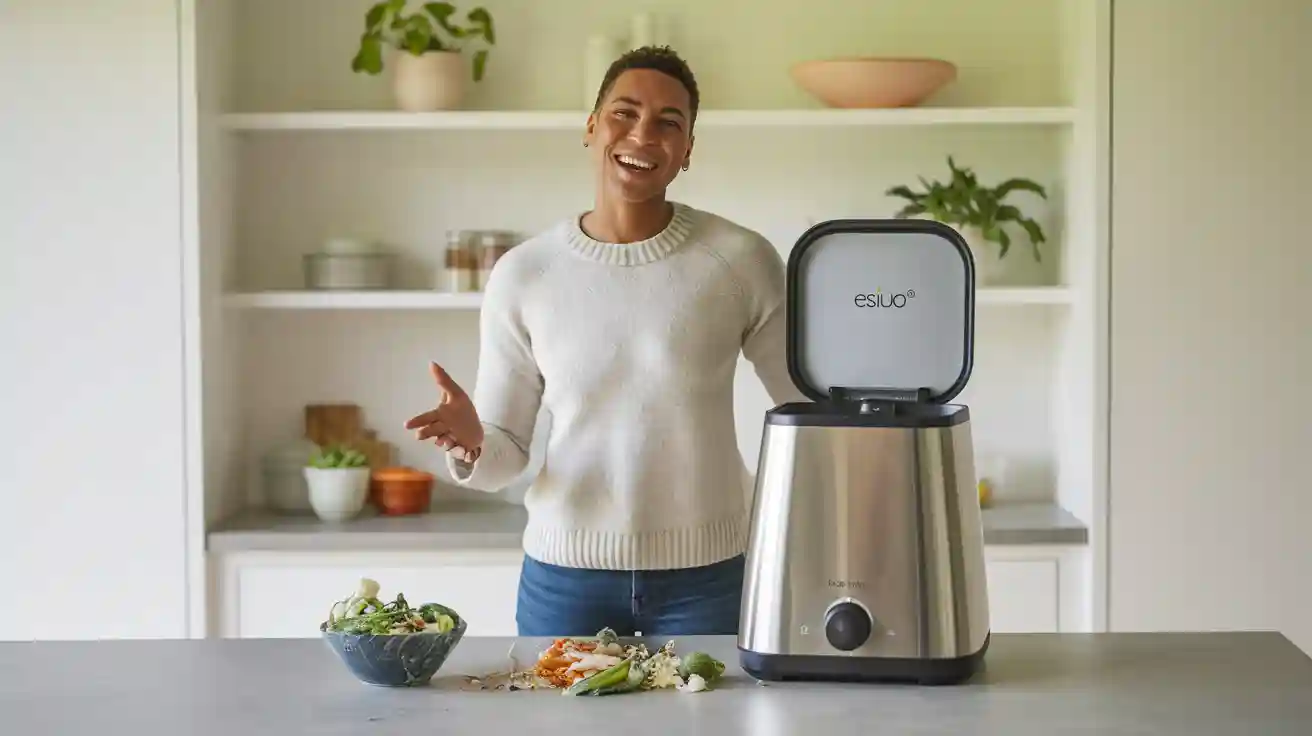
Ready to turn kitchen scraps into garden gold? With the ESIUO electric food composter, you can create nutrient-rich compost right at home. You just need the right approach to see amazing results. Get set to transform your food waste into something valuable—fast, easy, and mess-free.
Using Your ESIUO Electric Food Composter for Maximum Efficiency
Key Steps for Efficient Operation
You want your ESIUO electric food composter to work at its best every time. Start by following a few simple steps. These steps help you get the most compost in the shortest time, with less mess and better results.
Tip: Always read your composter’s manual before your first use. Each model has its own features and settings.
Here’s a quick guide to efficient operation:
- Sort your food waste. Only add items that the composter can handle. Avoid bones, large pits, and non-organic materials.
- Cut waste into small pieces. Smaller pieces break down faster and help the machine run smoothly.
- Balance your load. Mix wet and dry scraps. Too much moisture can slow things down, while dry items help keep the compost fluffy.
- Don’t overfill. Stick to the recommended fill line. Overloading can cause jams or uneven composting.
- Additives can help. Some users add sawdust or coffee grounds to improve compost quality and speed. Scientific studies show that sawdust boosts enzyme activity and helps create compost that’s safe for plants.
- Check the settings. Use the right mode for your load. Some cycles are faster for small batches, while others work better for larger amounts.
Here’s a table that shows how different additives and steps affect composting:
| Step or Additive | Effect on Composting |
|---|---|
| Sawdust | Boosts enzymes, makes compost safer for plants |
| Biochar | Raises pH, helps microbes, but may not remove all toxins |
| Proper timing | Improves compost maturity and quality |
| No additives | Reduces waste, but compost may not be fully mature |
| Mixing and heating | Cuts waste volume by up to 90% in 24 hours |
By following these steps, you help your electric food composter work faster and produce better compost. You also avoid common problems like bad smells or sticky messes.
Preparing Food Waste for Fast Composting
How you prepare your food scraps makes a big difference. The right prep means your compost finishes faster and smells better.
- Cut everything small. Chop or break food waste into pieces smaller than a grape. Research shows that pieces under 5 mm work best. Microbes can break down these small bits much faster. If you can get pieces down to 2 mm, you’ll see even quicker results.
- Mix in “compost superfoods.” Some foods help the process go faster and make your compost richer. Try adding:
- Strawberry leaves (full of vitamin C and minerals)
- Coffee grounds (high in nitrogen)
- Banana peels (packed with calcium and potassium)
- Keep it balanced. Don’t add only wet or only dry scraps. A good mix helps the composter control moisture and temperature. This balance keeps microbes happy and active.
- Spread scraps evenly. Don’t pile everything in one spot. Spread the waste around the bin so the stirring system can reach every piece.
Note: The ESIUO electric food composter uses heat, mixing, and microbes to break down waste. When you cut scraps small and mix them well, you help the machine do its job faster and more efficiently.
Here’s a quick look at how particle size affects composting speed:
| Particle Size | Composting Speed and Efficiency |
|---|---|
| Less than 5 mm | Fastest cycles; larger pieces slow things down |
| 2 mm | Best for microbes; speeds up composting the most |
When you follow these prep tips, you’ll notice your electric food composter works faster and produces better-smelling, richer compost. You’ll also spend less time cleaning and more time enjoying your garden or plants.
How the ESIUO Electric Food Composter Works
The Composting Process Explained
You might wonder what happens inside your electric food composter after you load it up. The ESIUO model uses a smart, three-stage process to turn your kitchen scraps into rich compost. Here’s how it works:
- Drying: The composter heats your food waste. This step shrinks the scraps and wakes up helpful microbes. The heat also kills off bad germs and weed seeds.
- Mixing: The machine stirs and grinds the waste. This action adds air and breaks the scraps into smaller bits. Sensors check the moisture, heat, and air levels to keep everything just right for fast composting.
- Cooling: The last step cools down the compost. The machine keeps drying and mixing a bit more. This makes sure your compost is safe to touch and ready to use in your garden.
Tip: Each stage helps speed up the process and gives you better compost with less effort.
Unique Features of the ESIUO Model
The ESIUO electric food composter stands out because of its smart design. You get sensors that watch over the temperature, moisture, and oxygen. These sensors help the machine adjust itself for the best results. The grinding blades chop up scraps so microbes can work faster. The composter also runs quietly, so you can use it any time of day. You don’t need to worry about bad smells, either. The built-in filter keeps your kitchen fresh.
If you want a simple way to handle food waste, this model makes it easy. You load it, press a button, and let the machine do the rest.
What to Compost and What to Avoid in an Electric Food Composter

Best Materials for Composting
You want your electric food composter to work its best, so choosing the right materials is key. Some kitchen scraps break down quickly and help create rich, healthy compost. Here are some top picks:
- Fruit and vegetable peels
- Coffee grounds and filters (no plastic pods)
- Tea leaves (without plastic bags)
- Eggshells (crushed)
- Bread (in small amounts)
- Small amounts of cooked rice or pasta
- Shredded paper towels (plain, no chemicals)
- Sawdust or straw (as bulking agents)
Adding bulking agents like sawdust or straw helps keep air flowing and stops bad smells. Studies show that these materials keep the compost airy, help microbes work faster, and reduce greenhouse gases. A good mix is about 15% bulking agent by volume.
A balanced mix of food scraps and bulking agents keeps your compost healthy and odor-free.
Items to Exclude for Optimal Performance
Some things just don’t belong in your electric food composter. They can cause bad smells, attract pests, or even damage your machine. Here’s what to leave out:
- Bones, shells, and hard pits
- Oils, fats, butter, and greasy foods
- Liquids or soups (unless drained)
- Meat, fish, and dairy products
- Candy, gum, and baked goods
- Citrus peels, onions, and garlic
- Coffee pods and tea bags with plastic
- Stickers on produce
- Coated cardboard, bioplastics, and cellophane
- Large branches or treated wood
- Coal, charcoal ash, or toxic plants
If you add these items, you risk bad odors, slow composting, or even machine problems. Some can also leave behind toxins or plastics that harm your garden. Always check your scraps before loading the bin.
Tip: Sorting your waste keeps your compost clean and safe for your plants. It also helps your electric food composter last longer.
Tips for Loading and Maintaining Your Electric Food Composter
Proper Loading Techniques
You want your electric food composter to run smoothly every time. Start by spreading your food scraps evenly inside the bin. This helps the machine mix everything well. Always keep the compost above the minimum fill line. If you go below this line, the microbes may not work as fast, and you might not get the best results.
Cut your scraps into small pieces before loading. This makes it easier for the blades to chop and mix. Avoid adding hard items like bones, fruit pits, or shells. These can damage the inside of your composter and slow down the process. If you use the composter often, you can add food at any time. The machine will adjust the cycle for you.
Tip: Mix wet and dry scraps for the best compost. Too much moisture can cause clumping, while dry scraps help keep things fluffy.
Cleaning and Blade Maintenance
Keeping your electric food composter clean helps it last longer. Wipe the inside with a damp cloth after each cycle. Check the blades for stuck food or buildup. If you see anything, gently remove it with a soft brush. Never use harsh cleaners or metal tools.
Replace the activated carbon filter every 4-6 months. This keeps your kitchen smelling fresh. Add a microbial supplement pack once a month to boost composting speed. Always keep the composter plugged in so it can run its energy-saving mode and control odors.
Here’s a quick guide to maintenance routines:
| Maintenance Routine | Description | Purpose/Benefit |
|---|---|---|
| Activated Carbon Filter Replacement | Replace every 4-6 months depending on usage frequency (2-3 times per week standard). | Prevents odors and maintains air quality. |
| Microbial Supplement Addition | Add microbial supplement pack once a month for optimal performance. | Enhances composting efficiency and microbial health. |
| Avoid Hard Substances | Do not compost bones, shells, tough husks, fruit pits, cooking oil, plastics, metals, etc. | Prevents damage to drying barrel coating and extends lifespan. |
| Maintain Minimum Fill Level | Keep compost amount above the minimum fill line at all times. | Ensures proper microbial activity and system function. |
| Continuous Power Connection | Keep the composter plugged in and on standby during use. | Enables energy-saving composting mode and odor control. |
| Adding Food During Operation | Food can be added anytime during operation; operation time adjusts accordingly. | Maintains continuous composting without interruption. |
Regular care keeps your electric food composter working like new and gives you great compost every time.
Optimizing Compost Quality and Output
Achieving Rich, Odor-Free Compost
You want your compost to smell fresh and look rich. The secret starts with what you put inside your electric food composter. Try to keep a good mix of kitchen scraps. Add both nitrogen-rich foods like spinach and carbon-rich items like bread or cereal. This balance helps microbes work faster and keeps odors away.
Here are some simple ways to get the best results:
- Add sawdust or activated charcoal. These help balance the carbon to nitrogen ratio and create air pockets. Air pockets let microbes breathe and break down waste better.
- Empty your composter often. After each cycle, sprinkle a little sawdust before starting a new batch.
- Make sure the machine has enough air flow and the scraps are not too wet or too dry.
- Use the built-in activated carbon filter. This filter traps bad smells and keeps your kitchen fresh.
- Replace the odor filter every 4-6 months. If you notice any smell, add used coffee grounds or bread, and pause adding new scraps for a day.
Tip: Electric food composters work fast, but you still need to check moisture and balance your scraps. A little attention goes a long way!
Safe Use and Further Processing of Compost Output
When your electric food composter finishes, you get dry, crumbly compost. This material is great for your garden, but it may need extra time to mature. The machine dries and chops scraps, but the heat can stop some microbes from finishing their job.
For the safest and richest compost, try these steps:
- Let the compost sit in a covered bin for a week or two. This gives microbes time to finish breaking down the material.
- Stir the compost every few days. Air helps the process and keeps it from smelling.
- If you want to use it right away, mix it with soil or mulch. This helps balance nutrients and keeps your plants safe.
Electric food composters make composting easy and quick. With a little extra care, you get healthy, odor-free compost that your plants will love.
Troubleshooting and Maximizing Efficiency with Your Electric Food Composter
Reducing Odors and Preventing Mess
Nobody likes a smelly kitchen or a sticky bin. You can keep your electric food composter fresh by following a few easy steps:
- Empty the bin often. Don’t let food scraps sit for too long.
- Rinse the bin with soap and water after each cycle. Let it dry before the next use.
- Add baking soda or charcoal to absorb odors.
- Use compostable paper towels to soak up extra moisture.
- Avoid adding foods that cause strong smells, like sugary treats or cabbage.
- Change the filter as recommended and keep the microbes healthy.
Tip: Regular cleaning and smart food choices help you avoid most messes and keep your composter running smoothly.
Saving Energy and Lowering Costs
You want to save money and help the planet. The ESIUO electric food composter uses about 0.8 to 1.5 kWh per cycle, which is like running a desktop computer for a few hours. You can lower your energy use by:
- Shredding food scraps before adding them. Smaller pieces break down faster.
- Only running full loads to get the most out of each cycle.
- Keeping your machine clean and well-maintained.
- Picking a compact model that fits your space.
These habits help you cut down on power bills and reduce waste disposal costs.
Addressing Environmental Impact
Electric food composters offer fast, odor-free composting and keep food waste out of landfills. They use electricity, so they do add to your carbon footprint. Here’s a quick look at how they compare to traditional composting:
| Aspect | Electric Food Composter | Traditional Composting |
|---|---|---|
| Methane Emissions | Low (aerobic, no methane) | Low if managed, can emit some |
| Energy Use | Uses electricity | No electricity needed |
| Compost Quality | Dry, needs maturing | Rich, stable compost |
| Speed | Fast (hours) | Slow (months) |
You get convenience and less landfill waste, but you should use your composter wisely to balance the benefits and impacts.
You can get great results with your electric food composter by following expert tips.
- Sort and prepare scraps for faster composting.
- Use your composter year-round, even in small spaces.
- Enjoy quick, odor-free compost and less waste at home.
Try these strategies and help your home stay green!
FAQ
Can I compost citrus peels in my ESIUO electric food composter?
You should avoid citrus peels. They can slow down composting and may cause strong odors. Stick with fruit and veggie scraps for best results.
How often should I clean my electric food composter?
Wipe the inside after each cycle. Clean the blades and replace the filter every few months. Regular cleaning keeps your composter working well.
What should I do if my compost smells bad?
Check for too much moisture or the wrong scraps. Add dry material like sawdust. Empty the bin and clean it. Replace the filter if needed.


